

The meanings and origins of sayings and phrases. Index of languages by writing system. Manx language, alphabet and pronunciation. Manx is a Celtic language spoken on the Isle of Man (Ellan Vannin).
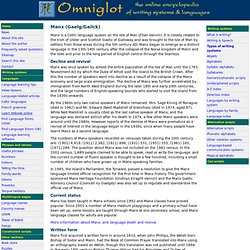
It is closely related to the Irish of Ulster and Scottish Gaelic of Galloway and was brought to the Isle of Man by settlers from those areas during the 5th century AD. Welsh language, alphabet and pronunciation. Welsh is a Celtic language spoken in Wales (Cymru) by about 740,000 people, and in the Welsh colony (yr Wladfa) in Patagonia, Argentina (yr Ariannin) by several hundred people.

There are also Welsh speakers in England (Lloegr), Scotland (yr Alban), Canada, the USA (yr Unol Daleithiau), Australia (Awstralia) and New Zealand (Seland Newydd). International Phonetic Alphabet (IPA) Origin The IPA was first published in 1888 by the Association Phonétique Internationale (International Phonetic Association), a group of French language teachers founded by Paul Passy.
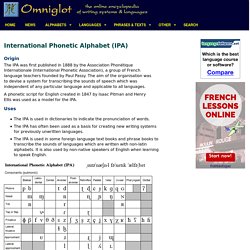
The aim of the organisation was to devise a system for transcribing the sounds of speech which was independent of any particular language and applicable to all languages. A phonetic script for English created in 1847 by Isaac Pitman and Henry Ellis was used as a model for the IPA. Uses. Index by writing direction. This is an index of the all the writing systems on this site arranged by the direction in which they are written.
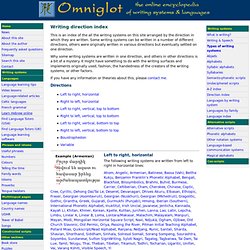
Some writing systems can be written in a number of different directions, others were originally written in various directions but eventually settled on one direction. Why some writing systems are written in one direction, and others in other directions is a bit of a mystery. It might have something to do with the writing surfaces and implements originally used, fashion, the handedness of the creators of the writing systems, or other factors.
If you have any information or theories about this, please contact me. Directions Left to right, horizontal. Rongorongo script and the Rapanui language. Origin. Ugaritic cuneiform. Origin Ugaritic cuneiform was named after Ugarit, the city state where it was used in what is now Syria. It was probably created sometime during the 14th century BC. Notable features Ugaritic cuneiform outwardly resembles other cuneiform scripts and has a sound system based on consonant alphabets such as Phoenician/Canaanite. Ugaritic was generally written from left to right in horizontal rows, though there are examples of it written in the opposite direction. Used to write: Ugaritic, a Semitic language closely related to Phoenician which was spoken in the city state of Ugarit in northern Syria.
The city was rediscovered in 1928 by a peasant whose plow uncovered an ancient tomb near Ras Shamrah in northern Syria. Links. Old Persian Cuneiform. Darius I (550-486 BC) claims credit for the invention of Old Persian Cuneiform in an inscription on a cliff at Behistun in south-west Iran.
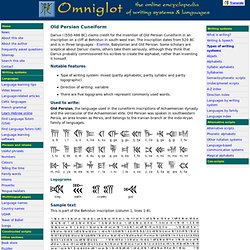
The inscription dates from 520 BC and is in three languages - Elamite, Babylonian and Old Persian. Some scholars are sceptical about Darius' claims, others take them seriously, although they think that Darius probably commissioned his scribes to create the alphabet, rather than inventing it himself. Notable features Type of writing system: mixed (partly alphabetic, partly syllabic and partly logographic) Direction of writing: variable There are five logograms which represent commonly used words. Used to write: Akkadian cuneiform. Akkadian was a semitic language spoken in Mesopotamia (modern Iraq and Syria) between about 2,800 BC and 500 AD.

It was named after the city of Akkad and first appeared in Sumerian texts dating from 2,800 BC in the form of Akkadian names. The Akkadian cuneiform script was adapted from Sumerian cuneiform in about 2,350 BC. At the same time, many Sumerian words were borrowed into Akkadian, and Sumerian logograms were given both Sumerian and Akkadian readings. Elamite scripts. Proto-Elamite The oldest Elamite script, known as Proto-Elamite, first appeared in about 3100 BC in Suse (Susa), the capital of Elam, in south-western Persia (modern Iran).
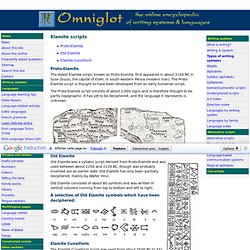
The Proto-Elamite script is thought to have been developed from an early Sumerian script. Elamite scripts. Proto-Elamite The oldest Elamite script, known as Proto-Elamite, first appeared in about 3100 BC in Suse (Susa), the capital of Elam, in south-western Persia (modern Iran).
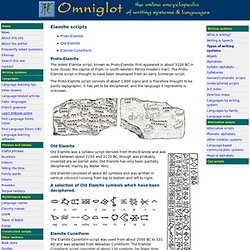
The Proto-Elamite script is thought to have been developed from an early Sumerian script. The Proto-Elamite script consists of about 1,000 signs and is therefore thought to be partly logographic. It has yet to be deciphered, and the language it represents is unknown. Linear A script. In 1900 the archaeologist Sir Arthur Evans (1851-1941) discovered a large number of clay tablets inscribed with mysterious symbols at Knossos on Crete.

Believing he had discovered the palace of King Minos, together with the Minotaur's labyrinth, Evans dubed the inscriptions and the language they represented as 'Minoan'. Evans spent the rest of his life trying to decipher the inscriptions, with only limited success. He realised that the inscriptions represented three different writing systems: a 'hieroglyphic' script, Linear A and Linear B. The hieroglphic script appears only on seal stones and has yet to be deciphered. Old European / Vinca writing. Origin These symbols have been found on many of the artefacts excavated from sites in south-east Europe, in particular from Vinča near Belgrade, but also in Greece, Bulgaria, Romania, eastern Hungary, Moldova, southern Ukraine and the former Yugoslavia.
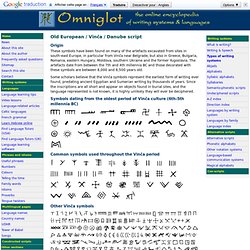
The artefacts date from between the 7th and 4th millennia BC and those decorated with these symbols are between 8,000 and 6,500 years old. Undeciphered scripts. The writing systems listed below have yet to be deciphered or have only been partially deciphered. In some cases the writing systems have been deciphered but the languages they were used to write remain a mystery. Vinča / Old European A collection of symbols found on many of the artefacts dating from between 6,000 to 4,500 BC excavated from sites in south-east Europe, in particular from Vinča near Belgrade. There is no agreement on whether these symbols are a writing system. Further details Indus/Harappa script. Semanto-phonetic writing systems. The symbols used in these semanto-phonetic writing systems often represent both sound and meaning. As a result, these scripts generally include a large number of symbols: anything from several hundred to tens of thousands. In fact there is no theoretical upper limit to the number of symbols in some scripts, such as Chinese.
These scripts could also be called logophonetic, morphophonemic, logographic or logosyllabic. Syllabaries. A syllabary is a phonetic writing system consisting of symbols representing syllables. A syllable is often made up of a consonant plus a vowel or a single vowel. Syllabic alphabets / Alphasyllabaries / Abugidas. Syllabic alphabets, alphasyllabaries or abugidas consist of symbols for consonants and vowels. The consonants each have an inherent vowel which can be changed to another vowel or muted by means of diacritics. Vowels can also be written with separate letters when they occur at the beginning of a word or on their own.
Abjads / Consonant alphabets. Abjads, or consonant alphabets, represent consonants only, or consonants plus some vowels. Full vowel indication (vocalisation) can be added, usually by means of diacritics, but this is not usually done. Runes, Alphabet of Mystery. Origins of the Runes. A reader directed me to a wonderful website called "Omniglot, a guide to writing systems", which illustrates examples of various alphabets of the world. By examining some of these we can begin to see the influences which may have led to development of the Germanic/Norse rune alphabets. It is commonly thought that the Etruscan and Latin alphabets were sources, but as you will see below, there may have been others, also.